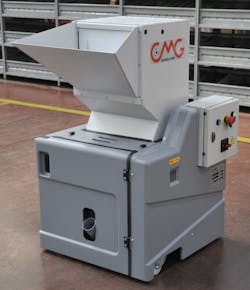Italian granulator manufacturer CMG SpA has two new machine series designed for injection and blow molding, one for thermoformed sheet and two models for post-consumer plastics.
The new granulators are all equipped with CMG’s adaptive motor power (AMP) feature that lets the granulator independently determine the power level it needs. AMP selects the minimum torque required based on the quantity of material to be ground, the temperature and the shape, weight, thickness and type of plastic.
GM Giorgio Santella said AMP provides a quick payback. It lets a user optimize the quality of the regrind by maximizing particle homogeneity while reducing dust and energy consumption, he said. A CMG granulator can use as little as 25 watt-hours (Wh) per kilogram, compared with 40 Wh or more for most granulators.
The AMP feature means that a processor or recycler can have the cost savings of running a smaller machine that is capable of handling bigger loads when needed.
CMG granulators are available in North America through Universal Dynamics Inc.
The new beside-the-press models for injection molding and blow molding are the G17-22 and G17-38 granulators. They can be configured in more than 50 variations, depending on application. There are two tangential-cut rotor blade designs available.
The units work with a slow motor speed of 155 rpm to 375 rpm. The standard screen is stainless steel. CMG said they are designed to open easily for maintenance and cleaning.
Throughput is 66 pounds to 110 pounds per hour for the G17-22 and 110 pounds to 154 pounds per hour for the G17-38.
The G17-22 is 25.6 inches wide, has a feed throat that is 12.9 inches (327mm) by 12.4 inches (315mm) and has nine blades. The G17-38 is 28.5 inches wide, has a feed throat that is 12.9 inches by 18.3 inches and has 15 knife blades. Both use a rotor that is 6.7 inches in diameter.
Two more new models, the G25-30 and G25-45, are designed for injection, blow molding and extrusion applications. There are 36 different configurations available, including a range of discharge systems.
The G25 units have adjustable cutting knives and lateral end discs that turn with the rotor. Both have a rotor that is 9.8 inches in diameter.
CMG offers three versions of the G25 series — the ET1, ET2 and ET3 — for edge-trim recovery on sheet and film extrusion lines. These models have tangential cutting blades and a self-ventilating cutting chamber for dust-free regrind.
Throughput of the G25-30 is 88 pounds to 308.6 pounds per hour; the G25-45’s throughput is 264.6 pounds per hour to 441 pounds per hour.
The G25-30 is 26 inches wide and has a cutting chamber feed opening that is 15 inches by 12.2 inches. The G25-45 is 31.7 inches wide and with a cutting chamber opening that is 15 inches by 18 inches.
For thermoforming, CMG has a new model, the XT35-120, designed for sheet recovery, skeletal waste and rejected packaging parts.
It has a cutting chamber with extended-performance steel blades optimized for sheet grinding. CMG also said it is equipped with a precision roller unit, double motors and automatic pressure control. It is suitable for in-line and off-line applications.
The new larger Evolution series is aimed at heavy-duty, post-consumer recycling. CMG said it uses 30 percent less power and blade replacement time is 50 percent faster than comparable models. It is suitable for dry or wet applications.
Blades can be adjustable or disposable blades can be used.
The EV916’s rotor is 36 inches in diameter and 63 inches long. The smaller EV616 has a 24-inch rotor that is 65 inches long.
The EV916 has a throughput of 6,614 pounds to 11,023 pounds per hour and the EV616 has a throughput of 3,307 pounds to 6,614 pounds per hour. A feed pusher can increase capacity by up to 40 percent, the company said.
Santella said the Evolution has a new cutting chamber design that extends blade life and also has advanced Industry 4.0 controls that make the machine easy to monitor and manage. Operating temperature, blade wear, productivity, operating efficiency and energy usage can be monitored remotely through the OPC-UA protocol connectivity.
Ron Shinn, editor
Contact:
Universal Dynamics Inc., Fredericksburg, Va., 703-490-7000, www.unadyn.piovan.com
About the Author
Ron Shinn
Editor
Editor Ron Shinn is a co-founder of Plastics Machinery & Manufacturing and has been covering the plastics industry for more than 35 years. He leads the editorial team, directs coverage and sets the editorial calendar. He also writes features, including the Talking Points column and On the Factory Floor, and covers recycling and sustainability for PMM and Plastics Recycling.
